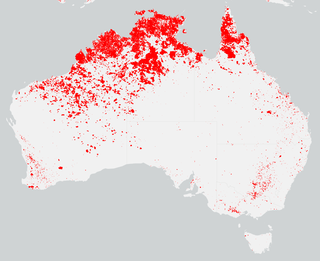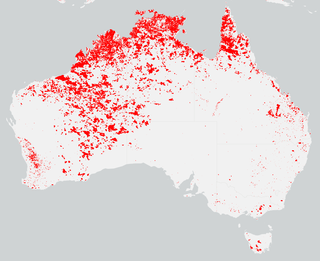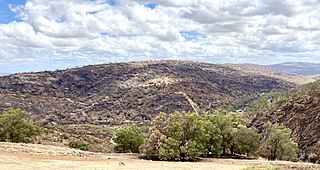
The Division of Pearce is an Australian electoral division in the state of Western Australia. It was created at the 1989 redistribution and named after George Pearce, the longest serving member of the Australian Senate, serving from 1901 to 1938. For most of its existence, Pearce was a hybrid urban-rural seat that covered Perth's outer northern suburbs before fanning inland from the Indian Ocean to take in portions of the Wheatbelt southeast, east and northeast of the capital. However, as of the 2021 redistribution, Pearce is largely coterminous with the City of Wanneroo in Perth's northern suburbs. It has had four members: Fred Chaney, Judi Moylan, Christian Porter, and Tracey Roberts. The first three were members of the Liberal Party, whereas Roberts, a former mayor of Wanneroo, is a member of the Labor Party.

The Department of Fire and Emergency Services (DFES) is a government department that is responsible for fire and emergency services in Western Australia. The department came into being in 2012 as a result of the Perth Hills Bush Fire review. DFES is responsible for the management, training and funding of career and volunteer Services including:

One of the most extensive bushfire seasons in Australia's history. Victoria experienced the longest continuously burning bushfire complex in Australia's history, with fires in the Victorian Alps and Gippsland burning over 1 million hectares of land over the course of 69 days. See Bushfires in Australia for an explanation of regional seasons.

A bushfire season occurred predominantly from June 2009 to May 2010. Increased attention has been given to this season as authorities and government attempt to preempt any future loss of life after the Black Saturday bushfires during the previous season, 2008–09. Long range weather observations predict very hot, dry and windy weather conditions during the summer months, leading to a high risk of bushfire occurrence.

During the summer of 2010–11, a relative lack of bushfires occurred along Eastern Australia due to a very strong La Niña effect, which instead contributed to severe flooding, in particular the 2010–11 Queensland floods and the 2011 Victorian floods. As a result of these weather patterns, most major fire events took place in Western Australia and South Australia. Some later significant fire activity occurred in Gippsland in eastern Victoria, an area which largely missed the rainfall that lead to the flooding in other parts of the state.

The summer of 2012–13 had above average fire potential for most of the southern half of the continent from the east coast to the west. This is despite having extensive fire in parts of the country over the last 12 months. The reason for this prediction is the abundant grass growth spurred by two La Niña events over the last two years.

The bushfire season in the summer of 2014–15, was expected to have the potential for many fires in eastern Australia after lower than expected rainfall was received in many areas. Authorities released warnings in the early spring that the season could be particularly bad.

The most destructive bushfire season in terms of property loss since the 2008–09 Australian bushfire season, occurred in the summer of 2015–16, with the loss of 408 houses and at least 500 non-residential buildings as a result of wild fires between 1 June 2015 and 31 May 2016. The season also suffered the most human fatalities since the 2008–09 Australian bushfire season; 6 died in Western Australia, 2 in South Australia and 1 in New South Wales. 8 deaths were as a direct result of fire, and a volunteer firefighter died due to unrelated health complications while on duty.

The 2015 Esperance bushfires were a series of catastrophic bushfires that burned from 15 to 26 November and affected the Goldfields-Esperance region in the Australian state of Western Australia. During the fires, the Shire of Esperance experienced two significant fires and a complex of fires; 128,000 hectares were burnt by the Cascades fire, 18,000 hectares were burnt by the Merivale fire, and 164,000 hectares were burnt by the Cape Arid complex of fires. On 17 November, during the major run of the Cascades fire, four civilian fatalities occurred in vehicles traveling on Griggs Road in Scaddan. As of 2020, the Cascades fire was equally the worst bushfire in Western Australia in terms of human fatalities along with the Willow Springs/Nannup fire of January 1958.
The 2014 Perth Hills bushfire, sometimes referred to as the Parkerville fire, was a bushfire that burned from 12 January to 1 February and affected the Mundaring municipality of the Perth Hills in the Australian state of Western Australia. During a major run of the fire on the afternoon and evening of 12 January, fifty-seven houses and numerous non-residential buildings were completely destroyed, and a further six houses were damaged in the suburbs of Mount Helena, Stoneville, and Parkerville. Approximately 386 hectares of uncleared land and pasture—the majority on private property—were burned during the 21-day duration of the fire. None of the residential subdivisions impacted had been formally declared as being within a bushfire prone area.

The bushfire season of the summer of 2017–18, was expected to have above normal bushfire risks with an elevated fire risk for the most of eastern and south Australian coastal areas. Australia had experienced its warmest winter on record and the ninth driest winter on record leaving dry fuel loads across much of southern Australia. Expected warmer weather over the summer period would also increase the risk. Bushfires were also expected to occur earlier, before the end of winter, as a result of the warm and dry winter. Both Queensland and north-eastern New South Wales experienced the wettest October since 1975 leading to a downgrade in bushfire risk.

The bushfires were predicted to be "fairly bleak" in parts of Australia, particularly in the east, by the Bushfire and Natural Hazards Cooperative Research Centre (CRC) chief executive, Richard Thornton, in September 2018. Large bushfires had already burned through southern New South Wales during winter. The outlook for spring was of a higher likelihood of fires with a twice the normal chance of an El Nino for summer. Many parts of eastern Australia including Queensland, New South Wales and Gippsland, in Victoria, were already in drought. Above normal fire was also predicted for large parts of Southern Australia and Eastern Australia by the Bushfire and Natural Hazards CRC. The forecast noted that Queensland had recorded the ninth driest and fourth hottest period on record from April to November. New South Wales recorded the fourth hottest period and eighth driest on record, while Victoria experiences the 13th driest and seventh hottest period on record. Authorities in New South Wales brought forward the start of the bushfire season for much of the state from October 2018 to the beginning of August 2018.

The 2019–20 Australian bushfire season, or Black Summer, was one of the most intense and catastrophic fire seasons on record in Australia. It included a period of bushfires in many parts of Australia, which, due to its unusual intensity, size, duration, and uncontrollable dimension, was considered a megafire by media at the time. Exceptionally dry conditions, a lack of soil moisture, and early fires in Central Queensland led to an early start to the bushfire season, beginning in June 2019. Hundreds of fires burnt, mainly in the southeast of the country, until May 2020. The most severe fires peaked from December 2019 to January 2020.
The 2020–21 Australian bushfire season was the season of summer bushfires in Australia. Following the devastating 2019–20 bushfires in Australia, authorities were urged to prepare early for the 2020–21 Australian bushfire season. The bushfire outlook for July to September 2020 was predicting a normal fire potential in Queensland with a good grass growth in many areas giving an increased risk of grass fires, an above normal season in the Kimberley region of Western Australia as a result of good rains from tropical cyclones, a normal but earlier season in the Northern Territory, an above normal season on the south coast of New South Wales and normal seasons elsewhere.

The 2021 Wooroloo bushfire was a fast moving bushfire that started on 1 February in Wooroloo, 45 kilometres (28 mi) north-east of the Perth central business district, in the Shire of Mundaring, Western Australia. By 2 February, the bushfire emergency had spread to Shires of Chittering and Northam, and the City of Swan. It had destroyed at least 86 houses and 2 fire trucks. By 6 February, the bushfire had travelled 26 km (16 mi) from its source. The fire coincided with a five day lockdown of the Perth metropolitan region that started at 6pm on 31 January, due to a case of COVID-19 outside of hotel quarantine. In July 2021, WA Police charged a man with a breach of duty and carrying out an activity that could cause a fire, alleging that he used an angle grinder that caused sparks.
The 2016 Waroona-Yarloop bushfire started in the east in the forests of the Darling Scarp before reaching the Swan Coastal Plain and continued westwards until it reached the Indian Ocean. It started as a lightning strike that caused two fires in the Lane Poole Reserve state forest near Dwellingup, Western Australia on 5 January 2016 and then burnt close to Waroona and then through the historical town of Yarloop, destroying it, before continuing southwards towards the outskirts of the town of Harvey and westwards to Preston Beach. Around 70,000 ha of land was burnt, two people died and at least 166 buildings were destroyed in Yarloop alone with only ninety buildings surviving. In total 181 buildings and structures were lost with the total cost of fighting the fire and the cost of the damage and the loss resulting estimated at $155 million.
The 2021–22 Australian bushfire season was the season of summer bushfires in Australia. The outlook for the season was below average in parts of Eastern Australia thanks to a La Niña, with elevated fire danger in Western Australia. Higher than normal winter rainfall has resulted in above average to average stream flows and soil moisture levels through much of eastern Australia. The outlook to the end of spring was also for above average falls over much of the country apart for Western Australia. The Australian Capital Territory, Victoria and southern New South Wales are expected to have a below normal fire potential as a result of vegetation still recovering from the 2020–21 Australian bushfire season. Areas of south eastern Queensland, northern New South Wales and northern Western Australia expect an above normal fire potential caused by crop and grass growth in these areas.
The 2021 Beechina bushfire was a bushfire that began on 26 December 2021 in Beechina, 46 kilometres east-north-east of the Perth central business district, in the Shire of Mundaring, Western Australia. The bushfire began less than five kilometres from the 2021 Wooroloo bushfire, and coincided with a COVID-19 outbreak and associated public health measures in the Perth metropolitan region. One house was destroyed as a result of the fire, along with six outbuildings and a number of vehicles.
The 2023–24 Australian bushfire season is the current season of bushfires in Australia. The spring and summer outlook for the season prediction was for increased risk of fire for regions in Queensland, New South Wales, Victoria, South Australia and the Northern Territory.
The 2023 Darling Downs fires was an Australian bushfire that began on 23 October 2023 after emergency warnings were issued for multiple bushfires in the Darling Downs region but particularly concentrated in the Western Downs Region and in Milmerran Woods. More than 40 fires burned across Darling Downs, with two fatalities in the town of Tara.












